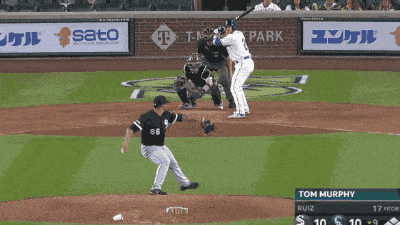It doesn't quite rank up there with the Jim Thome Revenge Game in terms of impact or the Daniel Hudson Revenge Game in terms of all-around dominance, but Omar Narvaez's Revenge Series this weekend in the canon of ill-advised trades repeating on the White Sox.
Trading Narvaez for Alex Colomé last winter wasn't an individual mistake on those levels, at least when it looked like the White Sox were gearing up for immediate action. When the offseason passed them by with Colomé and Kelvin Herrera the most consequential additions, the context made it harder to justify. The Sox, until the last two weeks, have been as good as you can be with late-inning leads, but the late-inning leads haven't been in large enough quantities to change the course of the season. Neither Colomé nor Herrera (lol) stood up as assets at the trade deadline, so if the Sox were hoping to generate trade value as a secondary outcome, that failed to materialize as well.
(Colomé's second half: 21.1 IP, 21 H, 15 R, 8 ER, 2 HR, 13 BB, 22 K.)
Narvaez is doing his part to push the second-guessing to another level, especially with the series he had against his former team. He went 4-for-10 with a walk and a walk-off "homer" on Saturday -- a fly ball that hit the yellow stripe on the padding and came back into the field of play, but one umpires never reviewed because they didn't seem to understand Rick Renteria's request. Of course, he had to hit it off Colomé.
That gave Narvaez his 21st homer, which represents both a step in the power development he showed last year, and also the chance that he's benefiting from the juiced ball as much as anybody.
| Season | PA | 2B | HR | BB% | K% | BA/OBP/SLG |
|---|---|---|---|---|---|---|
| 2018 | 322 | 14 | 9 | 11.8 | 20.2 | .275/.366/.429 |
| 2019 | 452 | 12 | 21 | 9.7 | 19.5 | .279/.354/.466 |
If you didn't count on his doubles turning into homers and think those columns could flip if Major League Baseball deadens its namesake, then nothing has really changed over last year. He'd still give the Sox a decent left-handed bat and their best strike-zone judgment, and he'd still be a hard guy to trust with getting the best out of pitchers, as his defensive numbers remain dreadful. Narvaez helped give the White Sox one of the top offensive catcher combos in the game in 2018, and we saw where that got them.
Dealing Narvaez wasn't necessarily the mistake. Acquiring Colomé wasn't necessarily a bad idea. Maybe even trading the former for the latter would've made sense as a finishing move for a contender. As one of the first moves for a GM who then planned his entire offseason around one specific player his boss wouldn't come close to landing, it ends up as perplexing as so many other Rick Hahn deals that have gone awry.
* * * * * * * * *
Dealing Narvaez for a closer would've also made more sense if Zack Collins could step up to replace Narvaez's presence as a left-handed defensive liability with patience and some pop. Right now, Collins' defensive issues are well ahead of the other aspects in the quest to replicate Narvaez's game.
His problems with framing really stood out over the weekend. He twice started against a good framer in Seattle catcher Tom Murphy, and both times the Sox ended up with largely unfavorable strike zones.
The plate Murphy coaxed out of Quinn Wolcott was notably wider than the one Collins yielded on Friday:

Sunday was a little bit better in terms of strikes gained, but worse in terms of strikes lost:

One of the blue dots on the fringes decided Sunday's game -- Jose Ruiz's full-count pitch to Murphy with the bases loaded and one out in the ninth. Statcast and Brooks Baseball both said it's right on the edge, and the broadcast also suggests it's the kind of pitch that defines the concept of "borderline."

In isolation, you could call it Ruiz missing his spot, or home plate umpire Alex Tosi just not being moved to call that particular pitch a strike, rather than examining the way Collins received it. But closing out a pair of games where the catchers were the constant and the Mariners benefited from a net advantage of roughly 15 favorable calls, it's worth focusing on the three-foot journey Collins' mitt takes.
Pair his receiving and blocking woes with his scuffling bat (.123/.254/.228 over 68 plate appearances), and there isn't a way to pencil in Collins to any future plans. The quality of his at-bats has improved since he returned, and we'll have a better sense whether it means anything when he faces a larger percentage of right-handed pitchers starting this week.
There's a path for Collins to succeed on an individual level and contribute to the team's success, but just as it was with Narvaez, it probably has to take the form of relinquishing defensive duties to two better catchers. Whether he can hit enough to not catch is another question, but if the Sox didn't wait around for Narvaez to present himself in that light, I don't see a reason to be more patient with Collins.





